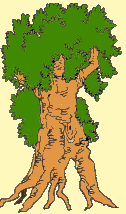ENTADA AFRICANA
ENTADA AFRICANA
ENTADA AFRICANA
ENTADA AFRICANA
Wolof: Mbathiar, samba saer Yoruba: ogurobe Goun and Fon: Kakè tin.
Family: Fabaceae
Synonym (s): Entada sudanica Schweinf.
Entada Africana is a small tree 4 to 10 m high and 90 cm in circumference; low branched, with a crown of width. the bark is gray-brown to black, very rough, transversely striped, scaly, flaking off in long fibrous bands, with fibrous, red, or yellow-brown slices. The leaves are alternate with 3 to 9 pairs, a common glabrous stem 15 to 45 cm long with 2 to 9 pairs of pinnae; 8-24 pairs of leaflets.
The leaflets have an elongated elliptical shape with a rounded top and sometimes minutely notched, with an asymmetric base with the lower edge more rounded than the upper part; midrib and distinct nerves on both sides. The flowers are creamy-white or reddish-yellow, 6 mm long, slightly fragrant, densely grouped in spike-like racemes 5-15 cm long, including the short central stem; peaks solitary or in small racemes in leaf axils or in panicles at the tip of shoots Sepals glabrous, small, lobed, with 3 5 x 1 mm petals, spatula, 10 stamens free.
The fruit is a very persistent pod, which hangs for several months on the tree, with the seeds showing through, straight or slightly curved, with thick wavy margins, brown-red on the outside; open break with segments of the dry part of the interior of the pod, containing 10 to 15 elliptical wide, flat seeds about 12 mm long.
E. africana grows in areas with high rainfall and in the savannah. Trees are found in the Sudanian zone, only exceptionally penetrating into the southern Sahel, Burkina Faso, Senegal, Cameroon, Uganda and Zaire. It occurs on lower slopes or banks of swamps, on groundwater sites. It is very susceptible to bushfires, often mutilated by it, and is widespread and abundant in Nigeria.
Geographical distribution
it is found in Burkina Faso, Cameroon, Democratic Republic of Congo, Nigeria, Senegal, passing from Sudan to Uganda
In Nigeria, flowers appear with the new leaves from February to April.
The leaves of E. Africana are good fodder. The fibers are used for making rope and creepers. The bark of the root and the stem produce a long fiber used for ropes, often for covering roofs> The leaves are used to make mats. Entada Africana produces a softwood that is easy to work with and a good quality rubber. The bark contains tannins. The leaves are used as a fish poison. The bark has abortive effects, while the root decoction is a stimulating and tonic agent. The leaves, bark, and roots are used to treat fever. In northern Nigeria and northern Ghana, an infusion of the leaves or bark is used as a tonic for general fatigue or an upset stomach. The leaves are also a good remedy for wounds, preventing suppuration.
Add a comment























